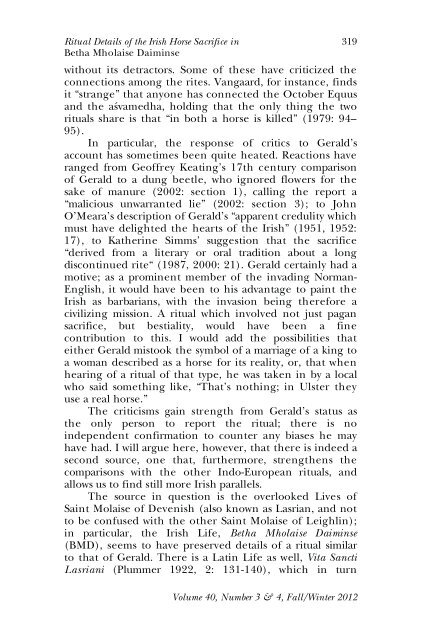Ritual Details of the Irish Horse Sacrifice in Betha ... - Clarkriley.com
Ritual Details of the Irish Horse Sacrifice in Betha ... - Clarkriley.com
Ritual Details of the Irish Horse Sacrifice in Betha ... - Clarkriley.com
Create successful ePaper yourself
Turn your PDF publications into a flip-book with our unique Google optimized e-Paper software.
<strong>Ritual</strong> <strong>Details</strong> <strong>of</strong> <strong>the</strong> <strong>Irish</strong> <strong>Horse</strong> <strong>Sacrifice</strong> <strong>in</strong> 319<br />
<strong>Betha</strong> Mholaise Daim<strong>in</strong>se<br />
without its detractors. Some <strong>of</strong> <strong>the</strong>se have criticized <strong>the</strong><br />
connections among <strong>the</strong> rites. Vangaard, for <strong>in</strong>stance, f<strong>in</strong>ds<br />
it “strange” that anyone has connected <strong>the</strong> October Equus<br />
and <strong>the</strong> aßvamedha, hold<strong>in</strong>g that <strong>the</strong> only th<strong>in</strong>g <strong>the</strong> two<br />
rituals share is that “<strong>in</strong> both a horse is killed” (1979: 94–<br />
95).<br />
In particular, <strong>the</strong> response <strong>of</strong> critics to Gerald’s<br />
account has sometimes been quite heated. Reactions have<br />
ranged from Ge<strong>of</strong>frey Keat<strong>in</strong>g’s 17th century <strong>com</strong>parison<br />
<strong>of</strong> Gerald to a dung beetle, who ignored flowers for <strong>the</strong><br />
sake <strong>of</strong> manure (2002: section 1), call<strong>in</strong>g <strong>the</strong> report a<br />
“malicious unwarranted lie” (2002: section 3); to John<br />
O’Meara’s description <strong>of</strong> Gerald’s “apparent credulity which<br />
must have delighted <strong>the</strong> hearts <strong>of</strong> <strong>the</strong> <strong>Irish</strong>” (1951, 1952:<br />
17), to Ka<strong>the</strong>r<strong>in</strong>e Simms’ suggestion that <strong>the</strong> sacrifice<br />
“derived from a literary or oral tradition about a long<br />
discont<strong>in</strong>ued rite“ (1987, 2000: 21). Gerald certa<strong>in</strong>ly had a<br />
motive; as a prom<strong>in</strong>ent member <strong>of</strong> <strong>the</strong> <strong>in</strong>vad<strong>in</strong>g Norman-<br />
English, it would have been to his advantage to pa<strong>in</strong>t <strong>the</strong><br />
<strong>Irish</strong> as barbarians, with <strong>the</strong> <strong>in</strong>vasion be<strong>in</strong>g <strong>the</strong>refore a<br />
civiliz<strong>in</strong>g mission. A ritual which <strong>in</strong>volved not just pagan<br />
sacrifice, but bestiality, would have been a f<strong>in</strong>e<br />
contribution to this. I would add <strong>the</strong> possibilities that<br />
ei<strong>the</strong>r Gerald mistook <strong>the</strong> symbol <strong>of</strong> a marriage <strong>of</strong> a k<strong>in</strong>g to<br />
a woman described as a horse for its reality, or, that when<br />
hear<strong>in</strong>g <strong>of</strong> a ritual <strong>of</strong> that type, he was taken <strong>in</strong> by a local<br />
who said someth<strong>in</strong>g like, “That’s noth<strong>in</strong>g; <strong>in</strong> Ulster <strong>the</strong>y<br />
use a real horse.”<br />
The criticisms ga<strong>in</strong> strength from Gerald’s status as<br />
<strong>the</strong> only person to report <strong>the</strong> ritual; <strong>the</strong>re is no<br />
<strong>in</strong>dependent confirmation to counter any biases he may<br />
have had. I will argue here, however, that <strong>the</strong>re is <strong>in</strong>deed a<br />
second source, one that, fur<strong>the</strong>rmore, streng<strong>the</strong>ns <strong>the</strong><br />
<strong>com</strong>parisons with <strong>the</strong> o<strong>the</strong>r Indo-European rituals, and<br />
allows us to f<strong>in</strong>d still more <strong>Irish</strong> parallels.<br />
The source <strong>in</strong> question is <strong>the</strong> overlooked Lives <strong>of</strong><br />
Sa<strong>in</strong>t Molaise <strong>of</strong> Devenish (also known as Lasrian, and not<br />
to be confused with <strong>the</strong> o<strong>the</strong>r Sa<strong>in</strong>t Molaise <strong>of</strong> Leighl<strong>in</strong>);<br />
<strong>in</strong> particular, <strong>the</strong> <strong>Irish</strong> Life, <strong>Betha</strong> Mholaise Daim<strong>in</strong>se<br />
(BMD), seems to have preserved details <strong>of</strong> a ritual similar<br />
to that <strong>of</strong> Gerald. There is a Lat<strong>in</strong> Life as well, Vita Sancti<br />
Lasriani (Plummer 1922, 2: 131-140), which <strong>in</strong> turn<br />
Volume 40, Number 3 & 4, Fall/W<strong>in</strong>ter 2012



